Abstract
Tyrannosaurid dinosaurs dominated as predators in the Late Cretaceous of Laurasia, culminating in the evolution of the giant Tyrannosaurus rex, both the last and largest tyrannosaurid. Where and when Tyrannosaurini (T. rex and kin) originated remains unclear. Competing hypotheses place tyrannosaurin origins in Asia, or western North America (Laramidia). We report a new tyrannosaurin, Tyrannosaurus mcraeensis, from the Campanian–Maastrichtian Hall Lake Formation of New Mexico, based on a fossil previously referred to T. rex. T. mcraeensis predates T. rex by ~ 6–7 million years, yet rivaled it in size. Phylogenetic analysis recovers T. mcraeensis as sister to T. rex and suggests Tyrannosaurini originated in southern Laramidia. Evolution of giant tyrannosaurs in southern North America, alongside giant ceratopsians, hadrosaurs, and titanosaurs suggests large-bodied dinosaurs evolved at low latitudes in North America.
Introduction
Tyrannosaurids were the dominant predators in North America and Asia during the Late Cretaceous1,2,3. Evolving from small-bodied ancestors in the mid-Cretaceous, tyrannosaurids became apex predators in the latest Cretaceous, and finally saw the appearance of Tyrannosaurus rex4,5. T. rex, characterized by a robust skeleton and powerful, bone-crushing jaws6, was the dominant carnivore in the late Maastrichtian of western North America3,7. Growing to 12 m long and ~ 10 tons in weight8, T. rex was the largest terrestrial predator of its time, and perhaps of all time.
The origins of the Tyrannosaurus lineage, Tyrannosaurini, are unknown. Tyrannosaurus rex appeared suddenly in the latest Maastrichtian3,7. No close relatives have been reported from North America prior to this time. Instead, the closest relatives of T. rex come from Mongolia. To explain this pattern, one hypothesis suggests tyrannosaurins dispersed into Asia via Beringia, followed by back-dispersal of Tyrannosaurini into Laramidia in the late Maastrichtian9,10,11. This hypothesis is based on the existence of stratigraphically earlier Asian taxa, Tarbosaurus bataar12 and Zhuchengtyrannus magnus13, which are close relatives of T. rex9,10,14,15. Alternatively, Tyrannosaurus has been hypothesized to represent an endemic, North American lineage14. Here, we describe NMMNH P-3698, a giant tyrannosaurid from the late Campanian—early Maastrichtian of New Mexico (Fig. 1). Although originally identified as T. rex16,17,18,19, this assignment has been questioned20. Restudy of the specimen, including newly recovered skeletal elements (Figs. 2, 3) confirm NMMNH P-3698 represents a distinct taxon, while recently published radiometric dates show that it predates T. rex by up to 7 million years. Phylogenetic analysis recovers NMMNH P-3698 as the closest known relative of T. rex, suggesting giant Tyrannosaurini evolved in southern Laramidia.
Cranial elements of Tyrannosaurus mcraeensis gen. et sp. nov. (NMMNH P-3698). Right postorbital in (A), lateral view; (B), medial view; (C), dorsal view. Right squamosal in (D), lateral view; (E), medial view; (F), ventral view. cor cornual boss, fos ventral fossa, fr frontal articulation, ltf lateral temporal fenestra, po postorbital articulation, sp suborbital process, stf supratemporal fossa, qc quadrate cotyle, qj quadratojugal process. Scale = 10 cm.
Mandibular elements of Tyrannosaurus mcraeensis gen. et sp. nov. (NMMNH P-3698). Left dentary in (A), medial view; (B), lateral view; (C), dorsal view; (D), right splenial, medial view; (E), right angular, medial view; (F), right prearticular, medial view. ang angular contact, de shelf for dentary, mec Meckelian canal, pre prearticular facet, a1, a5, a15 alveoli 1, 5, and 15, sp splenial, sym symphysis. Scale = 20 cm.
Systematic paleontology
Dinosauria—Owen, 1842.
Theropoda—Marsh, 1881.
Tetanurae—Gauthier, 1986.
Coelurosauria—von Huene, 1914.
Tyrannosauridae—Osborn, 1905.
Tyrannosaurinae—Currie, 2003.
Tyrannosaurini—Olshevsky, 1995.
Tyrannosaurus mcraeensis sp. nov.
LSID:
urn:lsid:zoobank.org:pub:F1658ACA-60DB-442E-AA04-015C050205BD.
(Tyrannosaurini is here defined as the last common ancestor of Tarbosaurus baatar and Tyrannosaurus rex and all its descendants).
Etymology
The species name, mcraeensis, refers to the McRae Group of western New Mexico.
Horizon and locality
Uppermost Campanian or lower Maastrichtian of the Hall Lake Formation, McRae Group, NMMNH locality 343, near Kettle Top Butte, Sierra County, New Mexico21 (Fig. 1A). The site lies 43 m above the base of the Hall Lake Formation. A tuff 33 m below the tyrannosaur site has a U/Pb age of 73.2 ± 0.7 Ma22 (Fig. 1B).
Diagnosis
Large tyrannosaurin distinguished from Tyrannosaurus rex (Fig. 4; SI) by the following characters (*autapomorphies): postorbital with low, posteriorly positioned cornual process; postorbital with anteriorly projecting prefrontal/frontal articular surfaces; squamosal with ventrally projecting quadratojugal process; squamosal with a concave medial margin; strong ridge bounding the anterior margin of the squamosal ventral pneumatic fossa; dentary very shallow posteriorly and with a convex posteroventral margin*; splenial with anteriorly positioned apex*; splenial with shelf-like dentary overlap*, splenial with deep, posteriorly directed angular process; prearticular weakly bowed*; small ventral prearticular-angular contact; articular T-shaped in dorsal/ventral view; retroarticular process deep and quadrangular in posterior view.
Holotype
NMMNH P-3698, partial skull including right postorbital and squamosal (Fig. 2), left palatine, fragment of maxilla, and lower jaws (Fig. 3) including left dentary, right splenial, prearticular, angular and articular, isolated teeth and associated chevrons.
Description and comparisons
The postorbital of Tyrannosaurus mcraeensis (Fig. 2A–C) is typical of tyrannosaurines5,12 in bearing a massive cornual boss projecting above the postorbital dorsal margin. The cornual boss is C-shaped as in Tarbosaurus12 but lacks the strong anteroventral expansion or undercut margin seen in Tarbosaurus and T. rex. The cornual boss lacks the prominent, anteriorly positioned apex above the orbit seen in T. rex, instead being more posteriorly positioned. The postorbital’s dorsal margin is arched, as in T. rex5. In dorsal view the orbital margin and the body of the postorbital form a wide angle, indicating a posteriorly expanded skull as in Lythronax14, Tarbosaurus12, and Tyrannosaurus rex5. The frontal/prefrontal suture projects forward, whereas it is downturned in T. rex (Fig. 4A). The jugal process is anteroposteriorly expanded, with a convex jugal contact, as in T. rex5 and T. bataar12. A large suborbital process projects forward to constrict the orbit as in Bistahieversor23, Teratophoneus14, and especially T. rex5 and Tarbosaurus12.
Tyrannosaurus mcraeensis compared with Tyrannosaurus rex. Postorbital of Tyrannosaurus mcraeensis (A1) and Tyrannosaurus rex (A2); Squamosal of (B1) Tyrannosaurus mcraeensis and (B2) Tyrannosaurus mcraeensis; Postorbital of (C1) Tyrannosaurus mcraeensis and (C2) Tyrannosaurus rex; prearticular of (D1) Tyrannosaurus mcraeensis and (D2) Tyrannosaurus rex; splenial of (E1) Tyrannosaurus mcraeensis and (E2) Tyrannosaurus rex; angular of (F1), Tyrannosaurus mcraeensis and (F2), Tyrannosaurus rex. Diagnostic characters: 1, low cornual process behind orbit; 2, anteriorly projected frontal/prefrontal articulation; 3, ventrally projected quadratojugal process; 4, upturned posteroventral margin of dentary; 5, weakly bowed prearticular; 6, anteriorly positioned splenial apex; 7, deep and posteriorly projected angular process; 8, shelf-like articulation overhanging dentary; 9, small splenial facet. Scale bars = 10 cm (A, B, D–F), 20 cm (C).
The squamosal (Fig. 2D–F) recalls Tyrannosaurus rex5 in being elongate in dorsal/ventral view. It is shorter in Tarbosaurus12, and especially Albertosaurinae24. It differs from the T. rex holotype, where the squamosal is straight (Fig. 4B) in having a strongly downturned end in lateral view; however some specimens of T. rex show this feature (SI1). The quadratojugal process is downturned relative to T. rex5 or Tarbosaurus12 and strongly curved. Ventrally, the squamosal bears a deep pneumatic recess. The recess’ anterior margin is defined by a transverse bar as in Tarbosaurus; this bar is reduced to a low ridge in T. rex12.
The palatine (SI5) is broad, similar to Tarbosaurus bataar12 but not to the degree seen in Tyrannosaurus rex; the palatine of Albertosaurinae is narrower24. This wide palatine contributes to the formation of a broad rostrum as in T. rex and Tarbosaurus.
The dentary (Fig. 3A–C) measures 645 mm from the tip back to the level of the coronoid process; the bone measures 894 mm along the long axis as preserved, however the posteroventral end is broken; it may have measured around 900 mm when complete. By comparison, corresponding measurements for the holotype of Tyrannosaurus rex are 589 and 855 mm; RSM P2523.8, one of if not the largest known T. rex specimens25, measures ~ 650 from the tip of the dentary to the coronoid process. Tyrannosaurus mcraeensis therefore overlaps T. rex in size (Fig. 5A), although the holotype is smaller than the largest known T. rex individuals. The dentary has 13 alveoli, a low tooth count uniquely shared with T. rex5 which typically has 13 dentary alveoli, and rarely 14 or 1526 alveoli. Zhuchengtyrannus has 15 teeth, Tarbosaurus has 14–1512,13; Daspletosaurus horneri10 and D. torosus have 17. The first alveolus is smaller than the second, as in other tyrannosaurins. The symphysis is deep, being about 125% the depth of the dentary at mid-length, as in T. rex. The symphysis’ anteroventral margin rises up steeply, creating a squared-off chin, again as in T. rex. The dentary’s occlusal margin rises up steeply at the back forming a strongly concave dorsal margin, as in other tyrannosaurines5,12,13,14. Unusually, the dentary’s posterior end is shallow and upturned; it is deep and typically has a downturned ventral margin in T. rex and other tyrannosaurids5,14,24. This condition is unique to T. mcraeensis but approached in Tarbosaurus5,12 and Zhuchengtyrannus13. The angular process projects posteriorly, as in Tarbosaurus and Zhuchengtyrannus13 but unlike T. rex and other tyrannosaurids, where it projects posteroventrally5,14,24.
Size, relationships and biogeography of Tyrannosaurus mcraeensis. (A), relative sizes of Tyrannosaurus mcraeensis (NMMNH P-3698) and Tyrannosaurus rex (FMNH PR 2081 and CM 9380) (after31); (B), evolutionary tree based on Bayesian tip-dated phylogeny and biogeographic analysis (see SI for full results).
In dorsal view the tip of the dentary bows outward so that the symphysis forms a broad “U”. Similar bowing is present in Tyrannosaurus rex5,14 and Tarbosaurus, associated with transverse expansion of the rostrum. The dentary tip is straight in Daspletosaurus, Lythronax14, Nanuqsaurus27 and more basal taxa28. The dentary and toothrow curve outwards posteriorly, again suggesting transverse expansion of the skull’s postorbital region, as in Lythronax14, Tarbosaurus, and T. rex5,12.
Medially, interdental plates are large and rectangular to triangular, as in other tyrannosaurins5,13; they are smaller in Albertosaurinae24 and Daspletosaurus24. The lingual bar covers the first two alveoli. It is deep anteriorly then narrows posteriorly to half its anterior depth, a condition otherwise seen only in Tyrannosaurus rex5. The symphysis is rugose and covered with bumps and grooves, as in other tyrannosaurines. It extends back to the third alveolus, as in Tarbosaurus12. In Zhuchengtyrannus13 and some individuals of T. rex5 it ends under the fourth alveolus. The symphysis lies above the dentary ventral margin, as in Tarbosaurus12 and Zhuchengtyrannus13; in T. rex the symphysis projects below the dentary’s ventral margin25 in some, but not all individuals. The bone’s lateral surface bears pits and scars suggestive of intraspecific combat.
The triangular splenial (Fig. 3D) resembles other tyrannosaurids5,12,24. The tall dorsal process resembles T. rex12 and Tarbosaurus12; Daspletosaurus24 has a low dorsal process. The apex is triangular, like Tarbosaurus; in T. rex the apex is usually quadrangular (Fig. 4e). The apex is anteriorly displaced compared to other tyrannosaurids. The ventral margin is straight, and the angular process projects posteriorly, versus posteroventrally in Tarbosaurus12 and Tyrannosaurus rex (Fig. 4E). The angular process is deep, as in Tarbosaurus; it is shallow in T. rex5. The anteroventral process, beneath the mylohyoid foramen, has a shelf overlapping the dentary, in T. rex it abuts the dentary.
The anterior process of the angular (Fig. 3E) is longer and narrower than in Tyrannosaurus rex (Fig. 4F) and more similar to Lythronax and Tarbosaurus. It has a narrow ventral prearticular contact; T. rex has a broad anteroventral flange here. The ventral margin forms a sharp angle between the anterior and posterior processes.
The prearticular (Fig. 3F) is gently curved, versus strongly bent in Tyrannosaurus rex5 (Fig. 4D) and other tyrannosaurids12,24. The articular is T-shaped in dorsal view, versus more triangular in T. rex. In posterior view, the retroarticular process is deep and subrectangular; that of T. rex is wider, and semicircular (SI).
Teeth (Fig. 3; SI) resemble Tyrannosaurus rex5 in being large, robust, and labiolingually expanded. Tooth crowns have massive apices, as in Tarbosaurus12; T. rex teeth have more pointed, spike-like apices5. The apex of the sixth dentary tooth is worn; T. rex tooth wear is often heavy as a result of biting bone6,29,30. The labiolingual width of anterior teeth approaches their mesiodistal diameter, as in T. rex; posterior teeth are robust, but more laterally compressed. Both carinae bear serrations.
Phylogenetic analysis
Phylogenetic analyses consistently recover Tyrannosaurus mcraeensis as sister to T. rex (Fig. 5) using either a parsimony-based or Bayesian tip-dated analysis (SI). The two share a reduced tooth count, deep dentary symphysis, posteriorly shallow lingual bar, and large size. T. mcraeensis is furthermore united with the Tarbosaurus + Tyrannosaurus clade by a postorbital with a broad ventral ramus, strongly convex posterior margin, and large suborbital flange, by the strongly concave dentary alveolar margin, and by the laterally bowed mandible.
Discussion
Systematics
NMMNH P-3698 was referred to Tyrannosaurus rex17,19,21 based on size and overall resemblance to T. rex, but this assignment has been questioned20. Newly collected material shows that T. mcraeensis differs from T. rex in the shape of the postorbital, squamosal, dentary, prearticular, angular, and articular. The characters that diagnose T. mcraeensis and differentiate it from T. rex are relatively subtle characters relating to the shape and articulation of the skull bones, but because T. rex is known from multiple individuals, it is possible to show that T. mcraeensis lies outside of the range of individual variation seen in T. rex (Fig. 6).
Variation in the postorbitals (A–F), dentaries (G–K) and splenials (M–Q) of Tyrannosaurus mcraeensis (A, G, M) and Tyrannosaurus rex (B–F, H–L, N–Q). See SI for specimen numbers. Scale bars = 10 cm.
Tyrannosaurus rex exhibits a high degree of variation31,32,33 and specimens assigned to the genus may or may not represent multiple species31,33,34. However in each of the diagnostic characters identified here, NMMNH P-3698 is unlike any other specimen referred to T. rex; furthermore each bone has at least one diagnostic character, it is therefore an outlier from all other specimens referred to T. rex, in every element. Neither can the differences between T. rex and T. mcraeensis be explained as ontogenetic, given that the animal matched T. rex in size. It is worth noting that these differences are subtle, but the differences between species are often relatively subtle. Characters diagnosing different species of Daspletosaurus10,15 tend to be relatively subtle, as are those diagnosing different species of Alioramus35.
Age of NMMNH P-3698
Referral of NMMNH P-3698 to Tyrannosaurus rex was also based on the assumption that the Hall Lake Formation is late Maastrichtian aged; but no geological or paleontological evidence supports this assignment. In fact, one of the main arguments for a late Maastrichtian age was the incorrect assumption that Hall Lake dinosaurs could be referred to the late Maastrichtian taxa Torosaurus and Tyrannosaurus rex19. The ceratopsid previously referred to Torosaurus is now identified as a distinct genus, Sierraceratops16; as shown here, NMMNH P-3698 is distinct from T. rex.
The dinosaur fauna suggests a latest Campanian or Maastrichtian age. Sierraceratops is similar to species known from the latest Campanian, including Coahuilaceratops magnacuerna36, and to Bravoceratops polyphemus from the Javelina Formation of Texas37, which is probably either latest Campanian or early Maastrichtian. The existence of a titanosaurian sauropod in the Hall Lake Formation has been cited evidence of a late Maastrichtian or ‘Lancian’ age19,38. Titanosaurs appear suddenly in the latest Cretaceous of the American Southwest, suggesting a distinct biogeographic event resulting from their sudden dispersal into North America39; sauropods are therefore a useful biostratigraphic constraint. However, titanosaurs range from just beneath the K-Pg boundary40 to at least 69 ± 0.9 Ma, i.e. mid-Maastrichtian40. Sauropods are unknown from the De-Na-Zin Member of the Kirtland Formation of New Mexico39, the top of which is dated to 73.5 Ma41, or the Cerro Del Pueblo Formation of Mexico, which is latest Campanian, ~ 73.5–73 Ma42. Sauropods therefore appear to immigrate into North America between 73 and 69 Ma. The existence of titanosaurs in the assemblage, therefore, does not reject a latest Campanian or early Maastrichtian age, and given that the sauropod appears higher in section, NMMNH P-3698 could predate the arrival of titanosaurians in North America. Finally, a large hadrosaur femur resembles that of the Campanian-Maastrichtian42 Edmontosaurus43 and a large edmontosaurin from the latest Campanian Cerro Del Pueblo Formation44 in terms of its large size and strongly inturned proximal femoral shaft. The presence of an edmontosaurin is consistent with an age range of latest Campanian to latest Maastrichtian. The dinosaur fauna as a whole is consistent with and suggests either a Campanian to Maastrichtian age. The ceratopsid Sierraceratops also tends to suggest a latest Campanian to early Maastrichtian age. Strikingly, no diagnostic late Maastrichtian dinosaur species are known.
Morphology also suggests Tyrannosaurus mcraeensis is older than T. rex, since it consistently lacks many derived characters characterizing T. rex. Tip-dated phylogenetic analysis recovers NMMNH P-3698 at 69 Ma, slightly younger than implied by the radiometric dates, but still much older than any known T. rex (Fig. 7).
Radiometric dates also point towards a latest Campanian or early Maastrichtian age. U/Pb dating22 gives an age of 73.2 ± 0.7 Ma for a tuff 9 m above the base of the Hall Lake Formation, and a series of Late Campanian ages for the upper 70 m of the immediately underlying Jose Creek Formation, at 75.2 ± 1.3 Ma, 74.6 ± 0.6 Ma, 74.9 ± 0.7 Ma, and 75.0 ± 1.1 Ma. Although no radiometric dates are found above NMMNH P-3698, a titanosaur is found 108 m above the site, and can be no younger than 66 Ma, i.e. the K-Pg boundary. No hiatus, coal, or other evidence of the K-Pg boundary is visible in the exposed section, suggesting around 150 m of Cretaceous rock overlay the site. Depending on the estimated rate of sedimentation, Tyrannosaurus mcraeensis may therefore have lived between 72.7 and 70.9 Ma (SI), i.e., latest Campanian or earliest Maastrichtian, 5–7 million years before Tyrannosaurus rex.
Overall, three independent lines of evidence—(i) the dinosaur fauna, (ii) the morphology of NMMNH P-3698 itself, and (iii) the age constraints provided by underlying radiometric dates and overlying dinosaur bones suggest an age somewhat older than the latest Maastrichtian, and that the animal predates Tyrannosaurus rex. However, additional radiometric dates, palynostratigraphy, or vertebrate fossils are needed to provide more precise constraints on the age of NMMNH P-3698.
Tyrannosaurus mcraeensis shows several derived characters T. rex does not: an upturned dentary posteroventral margin, a weakly curved prearticular, and an anterior splenial apex (Fig. 4). These characters imply that T. mcraeensis was a side-branch in tyrannosaurin evolution, and would not have been directly ancestral to Tyrannosaurus rex. If so, then at least two giant tyrannosaurids existed concurrently in North America, with another species ultimately giving rise to Tyrannosaurus rex.
Biogeography and the evolution of body size
Tyrannosaurus mcraeensis belonged to an endemic southern dinosaur community. The Hall Lake fauna (Fig. 8) included T. mcraeensis, the giant chasmosaur Sierraceratops16, the titanosaurian cf. Alamosaurus, and a giant hadrosaurid19. This fauna shows no overlap with penecontemporaneous faunas in the latest Campanian/early Maastrichtian of Canada. This northern fauna included the albertosaurine tyrannosaurid Albertosaurus, the centrosaurine Pachyrhinosaurus, the lambeosaur Hypacrosaurus, the hadrosaurs Edmontosaurus and Saurolophus, and the chasmosaurine Anchiceratops; sauropods are absent45. Discovery of T. mcraeensis, therefore, corroborates hypotheses that Laramidian faunas were characterized by high endemicity16,46,47,48, with the Southwest supporting distinct dinosaur species and clades (Fig. 8).
The presence of Tyrannosaurus mcraeensis in New Mexico and its phylogenetic position suggest that Tyrannosaurini14 originated as part of this southern fauna. A southern origin of Tyrannosaurini is further supported by the presence of cf. Tyrannosaurus in the Javelina Formation of Texas49,50 and T. rex in the latest Maastrichtian North Horn of Utah7. Following the appearance of tyrannosaurins in southern Laramidia during the Campanian, one lineage dispersed to Asia, giving rise to Tarbosaurus and Zhuchengtyrannus; another gave rise to Tyrannosaurus, eventually moving north to displace albertosaurines in the Late Maastrichtian.
In an alternative character-matrix51, Tyrannosaurus mcraeensis again emerges as sister to T. rex (SI). In this topology, Tarbosaurus and Zhuchengtyrannus are successive outgroups to the T. mcraeensis–T. rex clade. This topology is ambiguous about the origin of Tyrannosaurini, consistent with either two dispersals of Tyrannosaurinae into Asia, or dispersal into Asia, followed by back-dispersal into North America. The difference is due to the poorly known Zhuchengtyrannus acting as a wildcard taxon, clustering either with Tarbosaurus14 or as sister to the T. rex—Tarbosaurus clade9,10,15. The out-of-Asia scenario is dependent on the placement of this uncertain taxon. Resolving these ambiguities requires a better understanding of Asian tyrannosaurs. Similarly, placement of Daspletosaurus spp. along the line leading to Tyrannosaurini15 would tend to support a northern origin of the Tyrannosaurini. Further study of southern tyrannosaurs such as Bistahieversor and Lythronax can potentially resolve these issues, along with revisions of tyrannosaur phylogeny, but we argue that the appearance of T. rex-like dinosaurs in the Javelina Formation, which appear to be slightly older than T. rex itself, better fits the southern scenario9,50.
Tyrannosaurus mcraeensis shows that Tyrannosaurini achieved giant size near the end of the Campanian. It furthermore suggests that they did so in southern Laramidia (Fig. 5) but were initially restricted to southern Laramidia, and later dispersed north7. Chasmosaurinae show similar patterns, with giant Triceratopsini evolving in southern Laramidia in the Campanian, then moving into the northern Great Plains in the Maastrichtian46. Several other giant dinosaurs evolved in southern Laramidia, including large kritosaurin hadrosaurs52, the giant lambeosaurine Magnapaulia laticaudus53, and the titanosaurian Alamosaurus sanjuanensis54, but did not migrate north. Meanwhile, a tyrannosaurid from northernmost Laramidia, Nanuqsaurus hoglandi27, was smaller than tyrannosaurines from farther south. This, and the presence of giant ceratopsians and hadrosaurs in the Hall Lake Formation (SI) implies geographic patterns of body size evolution: large dinosaurs evolved in southern Laramidia.
Sea level changes have been hypothesized to drive tyrannosaurid diversification14, and among mammals, land area was found to be associated with body mass of top carnivores and herbivores55. However, the patterns raised here suggest that other processes are at work in driving tyrannosaurid size evolution. The evolution of Tyrannosaurus-sized tyrannosaurs appears to precede end-Maastrichtian marine regression by several million years; furthermore the giant tyrannosaurs appear to be initially restricted to a limted area of the relatively small Laramidian landmass. Gigantism therefore appears not to be driven by increases in land area, instead giant theropods evolved despite having relatively small geographic ranges.
Giant tyrannosaurins likely evolved to prey on the giant herbivores found in the south, although the reason for the evolution of large herbivorous dinosaurs—possibly including latitudinal variation in mean annual temperature, primary productivity, or seasonality—remains unknown. These patterns also suggest caution in relying on local dinosaur diversity patterns to study global dinosaur diversity changes preceding the K-Pg extinction.
Materials and methods
We added Tyrannosaurus mcraeensis to an existing character-taxon matrix14, adding 10 new characters as well as additional taxa (SI2). Phylogenetic analysis was implemented using cladistic methods and total-evidence estimation of phylogeny and divergence times using the fossilized clock model and birth–death priors under diversified sampling as described by recent authors56, with tip-dated estimates of fossil ages from all sampled taxa chosen using a “diversity” strategy to span internal branches. We optimized biogeographic history across the summary tree by classifying species into six areas: Europe, South America, Asia, Appalachia, Northern Laramidia, and Southern Laramidia, the latter two separated by present-day Utah and Colorado as the demarcating boundary. We tested a standard suite of biogeographic models in RASP57, selecting the DEC + J model as the best fit, and present the most-likely estimates for ancestral range (Fig. 5B).
Data availability
All data is available in the manuscript or Supporting Information.
References
-
Brusatte, S. L. et al. Tyrannosaur paleobiology: New research on ancient exemplar organisms. Science 329, 1481–1485 (2010).
-
Holtz, T. R. in The Dinosauria (eds D. B. Weishampel, P. Dodson, & H. Osmolska) 111–136 (University of California Press, 2004).
-
Weishampel, D. B. et al. in The Dinosauria (eds D. B. Weishampel, P. Dodson, & H. Osmolska) 517–606 (University of California Press, 2004).
-
Osborn, H. F. Tyrannosaurus and other Cretaceous carnivorous dinosaurs. Bull. Am. Museum Nat. Hist. 35, 733–771 (1905).
-
Brochu, C. A. Osteology of Tyrannosaurus rex: Insights from a nearly complete skeleton and high-resolution computed tomographic analysis of the skull. J. Vertebr. Paleontol. Mem. 7, 1–138 (2003).
-
Gignac, P. M. & Erickson, G. M. The biomechanics behind extreme osteophagy in Tyrannosaurus rex. Sci. Rep. 7, 1–10 (2017).
-
Sampson, S. D. & Loewen, M. A. Tyrannosaurus rex from the Upper Cretaceous (Maastrichtian) North Horn formation of Utah: Biogeographic and paleoecologic implications. J. Vertebr. Paleontol. 25, 469–472 (2005).
-
Hutchinson, J. R., Bates, K. T., Molnar, J., Allen, V. & Makovicky, P. J. A computational analysis of limb and body dimensions in Tyrannosaurus rex with implications for locomotion, ontogeny, and growth. PLoS ONE 6, e26037 (2011).
-
Brusatte, S. L. & Carr, T. D. The phylogeny and evolutionary history of tyrannosauroid dinosaurs. Sci. Rep. 6, 20252 (2016).
-
Carr, T. D., Varricchio, D. J., Sedlmayr, J. C., Roberts, E. M. & Moore, J. R. A new tyrannosaur with evidence for anagenesis and crocodile-like facial sensory system. Sci. Rep. 7, 1–11 (2017).
-
Carr, T. D. A high-resolution growth series of Tyrannosaurus rex obtained from multiple lines of evidence. PeerJ 8, e9192 (2020).
-
Hurum, J. H. & Sabath, K. Giant theropod dinosaurs from Asia and North America: Skulls of Tarbosaurus bataar and Tyrannosaurus rex compared. Acta Palaeontol. Pol. 48, 1–10 (2003).
-
Hone, D. W. et al. A new, large tyrannosaurine theropod from the Upper Cretaceous of China. Cretaceous Res. 32, 495–503 (2011).
-
Loewen, M. A., Irmis, R. B., Sertich, J. J., Currie, P. J. & Sampson, S. D. Tyrant dinosaur evolution tracks the rise and fall of Late Cretaceous oceans. PLoS ONE 8, e79420 (2013).
-
Warshaw, E. A. & Fowler, D. W. A transitional species of Daspletosaurus Russell, 1970 from the Judith River Formation of eastern Montana. PeerJ 10, e14461 (2022).
-
Dalman, S. G., Lucas, S. G., Jasinski, S. E. & Longrich, N. R. Sierraceratops turneri, a new chasmosaurine ceratopsid from the Hall Lake Formation (Upper Cretaceous) of south-central New Mexico. Cretaceous Res. 130, 105034 (2022).
-
Carr, T. D. & Williamson, T. E. A review of Tyrannosauridae (Dinosauria, Coelurosauria) from New Mexico. New Mexico Museum Nat. Hist. Sci. Bull. 17, 113–145 (2000).
-
Gillette, D., Wolberg, D. & Hunt, A. Tyrannosaurus rex from the McRae Formation (Lancian, Upper Cretaceous), Elephant Butte Reservoir, Sierra County, New Mexico. New Mexico Geol. Soc. Guidebook 37, 235–238 (1986).
-
Lozinsky, R. P., Hunt, A. P., Wolberg, D. L. & Lucas, S. Late Cretaceous (Lancian) dinosaurs from the McRae Formation, Sierra County, New Mexico. New Mexico Geol. 6, 7 (1984).
-
Lehman, T. M. & Carpenter, K. A partial skeleton of the tyrannosaurid dinosaur Aublysodon from the Upper Cretaceous of New Mexico. J. Paleontol. 64, 1026–1032 (1990).
-
Lucas, S. G., Nelson, W. J., Krainer, K. & Elrick, S. D. The Cretaceous System in central Sierra County, New Mexico. New Mexico Geol. 41, 3–39 (2019).
-
Amato, J. M., Mack, G. H., Jonell, T. N., Seager, W. R. & Upchurch, G. R. (2017). Onset of the Laramide orogeny and associated magmatism in southern New Mexico based on U-Pb geochronology. Bulletin 129, 1209–1226.
-
Carr, T. D. & Williamson, T. E. Bistahieversor sealeyi, gen. et sp. nov., a new tyrannosauroid from New Mexico and the origin of deep snouts in Tyrannosauroidea. J. Vertebr. Paleontol. 30, 1–16 (2010).
-
Currie, P. J. Cranial anatomy of tyrannosaurid dinosaurs from the Late Cretaceous of Alberta, Canada. Acta Palaeontol. Pol. 48, 191–226 (2003).
-
Persons, W. S. IV., Currie, P. J. & Erickson, G. M. An older and exceptionally large adult specimen of Tyrannosaurus rex. Anat. Rec. 303, 656–672 (2020).
-
Larson, P. The case for Nanotyrannus. Tyrannosaurid paleobiology, 15–53 (2013).
-
Fiorillo, A. R. & Tykoski, R. S. A diminutive new tyrannosaur from the top of the world. PLoS ONE 9, e91287 (2014).
-
Nesbitt, S. J. et al. A mid-Cretaceous tyrannosauroid and the origin of North American end-Cretaceous dinosaur assemblages. Nat. Ecol. Evol. 3, 892–899 (2019).
-
Longrich, N. R., Horner, J. R., Erickson, G. M. & Currie, P. J. Cannibalism in Tyrannosaurus rex. PLoS ONE 5(10), e13419 (2010).
-
Erickson, G. M. & Olson, K. H. Bite marks attributable to Tyrannosaurus rex: preliminary description and implications. Nat. Ecol. Evol. 16, 175–178 (1996).
-
Paul, G. S., Persons, W. S. & Van Raalte, J. The Tyrant Lizard King, queen and emperor: Multiple lines of morphological and stratigraphic evidence support subtle evolution and probable speciation within the North American genus Tyrannosaurus. Evol. Biol. 49, 156–179 (2022).
-
Carpenter, K. Variation. in Tyrannosaurus rex. Dinosaur systematics: perspectives and approaches, 141–145 (1990).
-
Larson, P. Variation and sexual dimorphism in Tyrannosaurus rex. Tyrannosaurus rex, the tyrant king, 103–128 (2008).
-
Carr, T. D. et al. Insufficient evidence for multiple species of Tyrannosaurus in the latest Cretaceous of North America: A comment on “The Tyrant Lizard King, queen and emperor: Multiple lines of morphological and stratigraphic evidence support subtle evolution and probable speciation within the North American genus Tyrannosaurus”. Evol. Biol. 1, 1–15 (2022).
-
Brusatte, S. L., Carr, T. D., Erickson, G. M., Bever, G. S. & Norell, M. A long-snouted, multihorned tyrannosaurid from the Late Cretaceous of Mongolia. Proc. Natl. Acad. Sci. 106, 17251–17266 (2009).
-
Loewen, M. A. et al. in New Perspectives on Horned Dinosaurs: The Royal Tyrrell Museum Ceratopsian Symposium (eds M. J. Ryan, B. J. Chinnery, & D. A. Eberth) 99–116 (Indiana University Press, 2010).
-
Wick, S. L. & Lehman, T. M. A new ceratopsian dinosaur from the Javelina Formation (Maastrichtian) of West Texas and implications for chasmosaurine phylogeny. Naturwissenschaften https://doi.org/10.1007/s00114-013-1063-0 (2013).
-
Wolberg, D. L., Lozinsky, R. P. & Hunt, A. P. Late Cretaceous (Maastrichtian-Lancian) vertebrate paleontology of the McRae Formation, Elephant Butte area, Sierra County, New Mexico. New Mexico Geol. Soc. Guidebook 37, 227–334 (1986).
-
Williamson, T. E. & Weil, A. Stratigraphic distribution of sauropods in the Upper Cretaceous of San Juan Basin, New Mexico, with comments on North America’s Cretaceous “Sauropod Hiatus”. J. Vertebr. Paleontol. 28, 1218–1223 (2008).
-
Lehman, T. M., McDowell, F. W. & Connelly, J. N. First isotopic (U-PB) age for the Late Cretaceous Alamosaurus vertebrate fauna of West Texas, and its significance as a link between two faunal provinces. J. Vertebr. Paleontol. 26, 922–928 (2006).
-
Ramezani, J., Beveridge, T. L., Rogers, R. R., Eberth, D. A. & Roberts, E. M. Calibrating the zenith of dinosaur diversity in the Campanian of the Western Interior Basin by CA-ID-TIMS U-Pb geochronology. Sci. Rep. 12, 16026 (2022).
-
Fowler, D. W. Revised geochronology, correlation, and dinosaur stratigraphic ranges of the Santonian-Maastrichtian (Late Cretaceous) formations of the Western Interior of North America. PLoS ONE 12, e0188426 (2017).
-
Campione, N. E. Hadrosaurs (Indiana University Press, 2015).
-
Kirkland, J. I. et al. Large hadrosaurine dinosaurs from the latest Campanian of Coahuila, Mexico. New Mexico Museum Nat. Hist. Sci. Bull. 35, 299–315 (2006).
-
Eberth, D. A. & Kamo, S. L. High-precision U-PB CA–ID–TIMS dating and chronostratigraphy of the dinosaur-rich Horseshoe Canyon Formation (Upper Cretaceous, Campanian–Maastrichtian), Red Deer River Valley, Alberta, Canada. Can. J. Earth Sci. 57, 1220–1237 (2020).
-
Longrich, N. R. Titanoceratops ouranos, a giant horned dinosaur from the Late Campanian of New Mexico. Cretaceous Res. 32, 264–276 (2011).
-
Lehman, T. M. Late Maastrichtian paleoenvironments and dinosaur biogeography in the Western Interior of North America. Palaeogeogr. Palaeoclimatol. Palaeoecol. 60, 189–217 (1987).
-
Sampson, S. D. et al. New horned dinosaurs from Utah provide evidence for intracontinental dinosaur endemism. PLoS ONE 5, e12292 (2010).
-
Lawson, D. A. Tyrannosaurus and Torosaurus, Maestrichtian dinosaurs from Trans-Pecos, Texas. J. Paleontol. 50, 158–164 (1976).
-
Wick, S. L. New evidence for the possible occurrence of Tyrannosaurus in West Texas, and discussion of Maastrichtian tyrannosaurid dinosaurs from Big Bend National Park. Cretaceous Res. 50, 52–58 (2014).
-
Voris, J. T., Therrien, F., Zelenitsky, D. K. & Brown, C. M. A new tyrannosaurine (Theropoda: Tyrannosauridae) from the Campanian Foremost Formation of Alberta, Canada, provides insight into the evolution and biogeography of tyrannosaurids. Cretaceous Res. 110, 104388 (2020).
-
Prieto-Márquez, A. Skeletal morphology of Kritosaurus navajovius (Dinosauria: Hadrosauridae) from the Late Cretaceous of the North American south-west, with an evaluation of the phylogenetic systematics and biogeography of Kritosaurini. J. Syst. Palaeontol. 12, 133–175 (2014).
-
Prieto-Márquez, A., Chiappe, L. M. & Joshi, S. H. The lambeosaurine dinosaur Magnapaulia laticaudus from the Late Cretaceous of Baja California, Northwestern Mexico. PLoS ONE 7, e38207 (2012).
-
Fronimos, J. A. & Lehman, T. M. New specimens of a titanosaur sauropod from the Maastrichtian of Big Bend National Park, Texas. J. Vertebr. Paleontol. 34, 883–899 (2014).
-
Burness, G. P., Diamond, J. & Flannery, T. Dinosaurs, dragons, and dwarfs: The evolution of maximal body size. Proc. Natl. Acad. Sci. 98, 14518–15523 (2001).
-
Ronquist, F. et al. MrBayes 3.2: Efficient Bayesian phylogenetic inference and model choice across a large model space. Syst. Biol. 61, 539–542 (2012).
-
Yu, Y., Blair, C. & He, X. RASP 4: Ancestral state reconstruction tool for multiple genes and characters. Mol. Biol. Evol. 37, 604–606 (2020).
Acknowledgements
The dentary, palatine, and prearticular of NMMNH P-3698 were collected by D. Gillette; additional remains were collected by T. Williamson. Photos for the SI courtesy T. Miyashita.
Author information
Authors and Affiliations
Contributions
S.G.D., N.R.L., M.A.L. designed the project. S.G.D., S.G.L., M.A.L., R.A.P., S.E.J., D.E.M., A.R.F., P.J.C. conducted research and wrote the paper. S.G.D., M.A.L., N.R.L. and R.A.P. conducted the phylogenetic analysis.
Corresponding author
Ethics declarations
Competing interests
The authors declare no competing interests.
Additional information
Publisher's note
Springer Nature remains neutral with regard to jurisdictional claims in published maps and institutional affiliations.
Supplementary Information
Rights and permissions
Open Access This article is licensed under a Creative Commons Attribution 4.0 International License, which permits use, sharing, adaptation, distribution and reproduction in any medium or format, as long as you give appropriate credit to the original author(s) and the source, provide a link to the Creative Commons licence, and indicate if changes were made. The images or other third party material in this article are included in the article's Creative Commons licence, unless indicated otherwise in a credit line to the material. If material is not included in the article's Creative Commons licence and your intended use is not permitted by statutory regulation or exceeds the permitted use, you will need to obtain permission directly from the copyright holder. To view a copy of this licence, visit http://creativecommons.org/licenses/by/4.0/.
About this article
Cite this article
Dalman, S.G., Loewen, M.A., Pyron, R.A. et al. A giant tyrannosaur from the Campanian–Maastrichtian of southern North America and the evolution of tyrannosaurid gigantism. Sci Rep 13, 22124 (2023). https://ift.tt/4ef1mR8
-
Received:
-
Accepted:
-
Published:
-
DOI: https://ift.tt/4ef1mR8
Comments
By submitting a comment you agree to abide by our Terms and Community Guidelines. If you find something abusive or that does not comply with our terms or guidelines please flag it as inappropriate.
https://ift.tt/f7PpkMh
Science
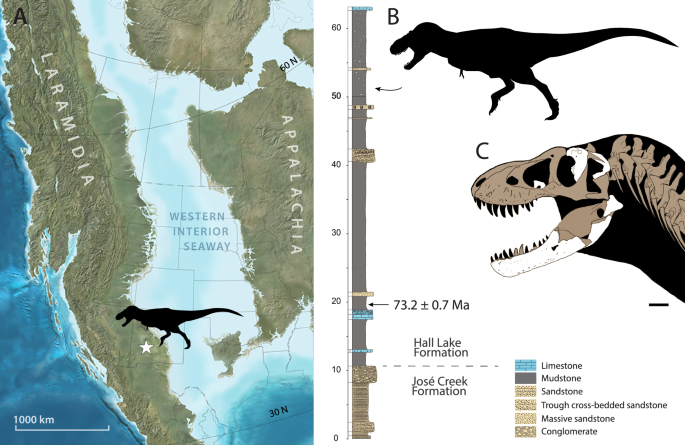
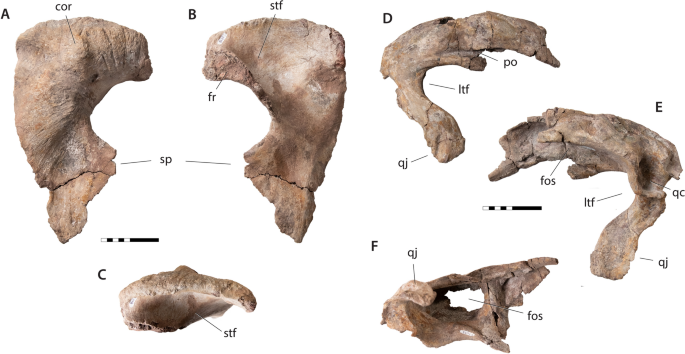
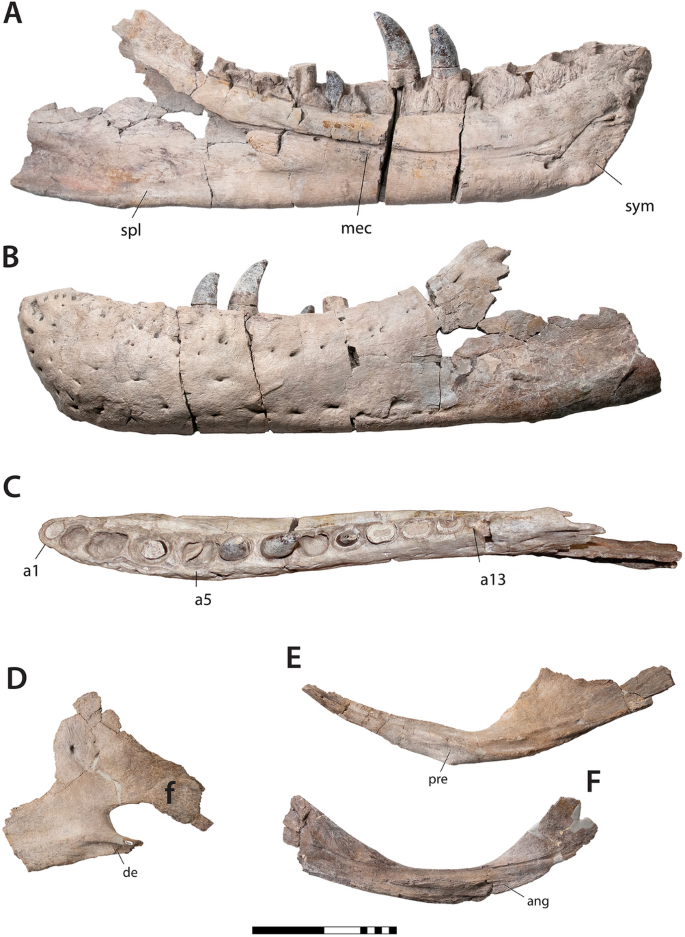

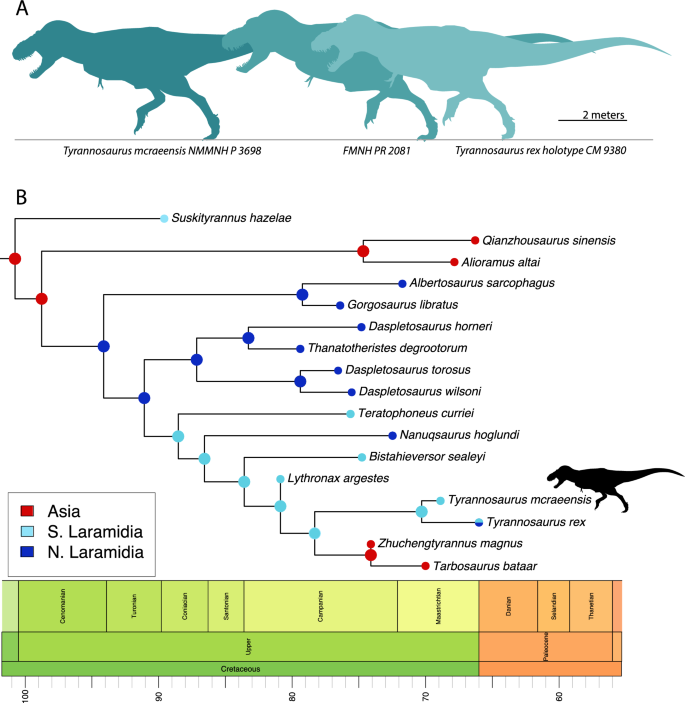
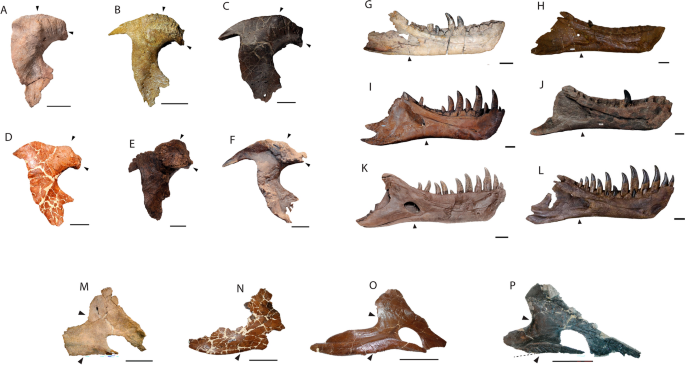
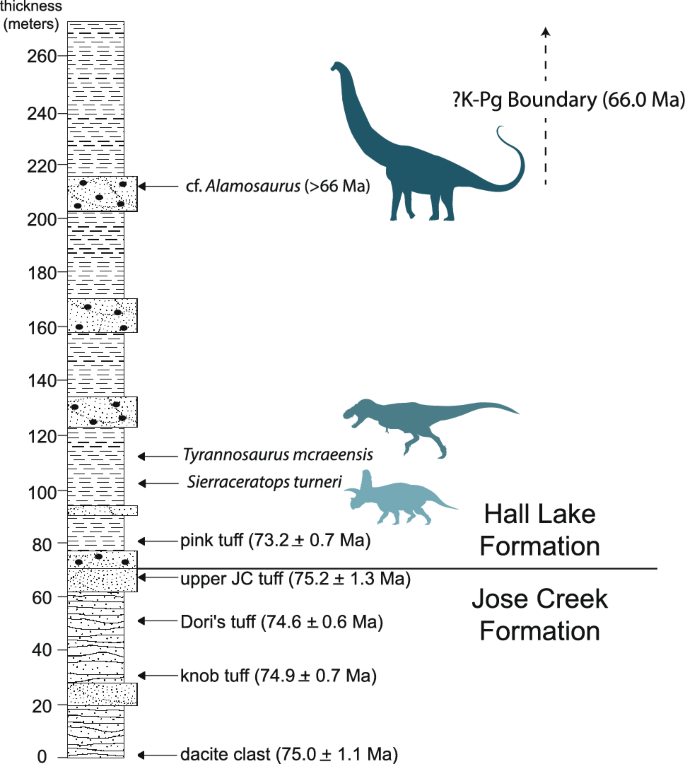

No comments:
Post a Comment